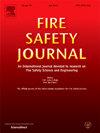隧道内全面搜救实验中消防员的耗气量和移动速度分析
IF 3.4
3区 工程技术
Q2 ENGINEERING, CIVIL
引用次数: 0
摘要
在一条长 420 米的死胡同隧道中进行了实验,以评估空气消耗量和移动速度。行动包括步行 417 米寻找和营救一名受害者。由 5 名蒙眼消防员组成的 7 个小组携带单瓶 SCBA、担架和移动手杖进入隧道。14 名消防员(即 44%)不得不使用 "备用空气"。因此,进行这样的操作并不安全。不过,所有人员都注意到了他们使用了瓶中一半可用空气的迹象,因此可以在隧道中开始 S&R 操作,并在 175 bar 刻度处安全返回。平均完成时间为 35.2 分钟。所有工作人员都更善于使用手杖,因此走出隧道的平均移动速度(0.50 米/秒)高于进入隧道的平均移动速度(0.39 米/秒)。每行走一米的平均耗气量为:进入隧道 2.20 升/米,离开隧道 1.33 升/米。进入隧道的平均耗气量为 49.9 升/分钟,走出隧道的平均耗气量为 38.9 升/分钟。结果表明,速度起着重要作用。速度较快的消防员总耗气量较低。本文章由计算机程序翻译,如有差异,请以英文原文为准。
Analysis of air consumption and moving speed by firefighters during full-scale search & rescue experiments in a tunnel
Experiments were carried out in a 420 m long dead-end tunnel to assess air consumption and movement speed. The operation consisted of a 417 m walk to locate and rescue a victim. Seven teams of 5 blindfolded firefighters were sent into the tunnel with a single-bottle SCBA, a stretcher and a mobility cane. 14 firefighters (i.e., 44 %) had to use ‘reserve air’. Hence it is not considered safe to carry out such an operation. However, all the crews noticed the sign that they used half of the available air in their bottle, so it is possible to start the S&R operation in a tunnel and safely return at the 175 bar mark. The average time to completion was 35.2 min. All crews became better at using the cane, leading to a higher average movement speed (0.50 m/s) out of the tunnel than into the tunnel (0.39 m/s). The average air consumption per walking meter was 2.20 L/m going in and 1.33 L/m going out. The average air consumption rate was 49.9L/min going into the tunnel and 38.9 L/min going out of the tunnel. It is shown that speed plays an important role. Faster firefighters have a lower total air consumption.
求助全文
通过发布文献求助,成功后即可免费获取论文全文。
去求助
来源期刊

Fire Safety Journal
工程技术-材料科学:综合
CiteScore
5.70
自引率
9.70%
发文量
153
审稿时长
60 days
期刊介绍:
Fire Safety Journal is the leading publication dealing with all aspects of fire safety engineering. Its scope is purposefully wide, as it is deemed important to encourage papers from all sources within this multidisciplinary subject, thus providing a forum for its further development as a distinct engineering discipline. This is an essential step towards gaining a status equal to that enjoyed by the other engineering disciplines.
 求助内容:
求助内容: 应助结果提醒方式:
应助结果提醒方式:


